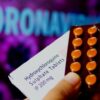Researchers have managed to create artificial red blood cells that can transport medication. Compared to the popular anticoagulant Warfarin, NOAC’s may be superior for treating atrial fibrillation patients with prior intracranial hemorrhage. Also, surgery may be the preferred choice for reducing leg pain in patients with sciatica.
Synthetic Red Blood Cells to Deliver Medication
Researchers have managed to create artificial red blood cells (RBCs) that function the same as natural RBCs and can also deliver drugs and detect toxins, Science Daily reports. Preliminary testing found that the cells survived in mice for 48 hours and presented no toxicity and that the RBCs were capable of carrying “cargo” such as hemoglobin and anticancer drugs. What’s more, the RBCs can act as a decoy against bacterial toxins produced by microorganisms, which can promote infection and disease.
While artificial cells’ capabilities need to be studied further, this could prove to be an innovative way to deliver medication more directly to patients in need.
NOAC’s versus Warfarin For Treating Atrial Fibrillation
Treating Atrial Fibrillation can be tricky. AFib increases your risk of blood clots, which can lead to a stroke. Anticoagulants are prescribed to help offset the clotting, but, unfortunately, intracranial hemorrhage is a common side-effect of the drugs. Once a person with AFib experiences intracranial hemorrhage, the risk of having a stroke and dying increases.
There are two common types of anticoagulants. The first is warfarin, brand name Coumadin, which has been used for decades and is well known. The second type is called NOAC’s (short for non–vitamin K antagonist oral anticoagulants) and is sold under the brand names of Eliquis, Pradaxa and Xarelto. There was almost no data on which is less likely to induce a stroke in atrial fibrillation patients with ICH. Until now.
A recent study in JAMA examined 4,540 patients with prior ICH who took either warfarin or NOAC’s. Of the two groups, those who took NOAC’s had significantly lower rates of intracranial hemorrhaging, major bleeding, and all-cause mortality. The study concluded that NOAC’s are likely the preferred anticoagulant among AF patients with prior intracranial hemorrhage.
Surgery Superior to Nonsurgical Care in Patients with Sciatica
If you’re experiencing intense pain from sciatica, then surgery may be your best bet for relief. A study in the New England Journal of Medicine split into two groups 128 people who suffered a disc herniation in the lumbar spine (lower back) and had sciatica lasting four to 12 months. One of the groups had a microdiscectomy performed and the other group received six months of “standardized nonoperative care followed by surgery if needed.” Twenty-two patients in the NS group ended up undergoing surgery.
After six months, the two groups rated their level of leg pain (sciatica’s primary symptom) on a scale of one through 10. The nonsurgical group’s median pain score was 5.2, which was about double the surgical group’s pain rating of 2.8. Nine of the patients reported adverse effects due to surgery, and one individual underwent repeat surgery. Still, the study concludes that a microdiscectomy may be preferred over nonsurgical care for pain relief from sciatica.






